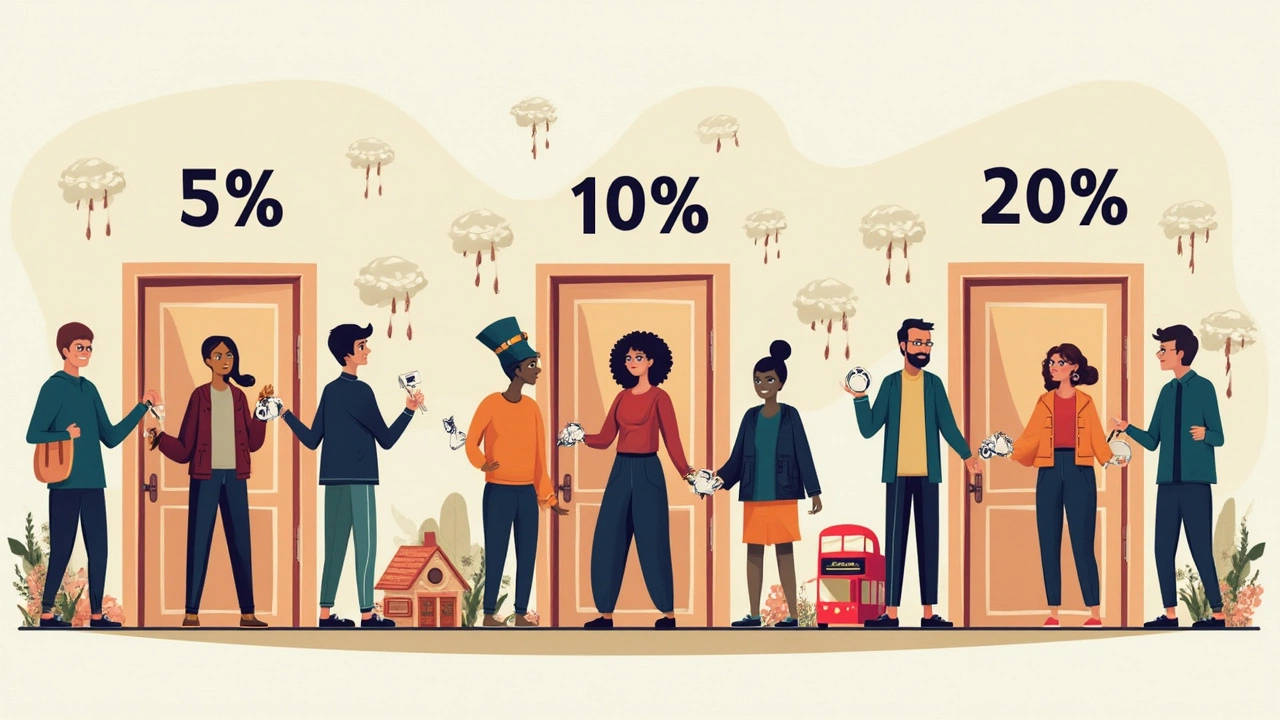Do You Have to Put 10% Down on a House?
 May, 1 2025
May, 1 2025
Who decided you have to put 10% down to buy a house? That number gets tossed around like it's set in stone, but in reality, it's just one option—not the hard rule. Tons of first-time buyers think they can't even start house hunting unless they've stashed away a pile of cash that equals exactly 10% of what they're hoping to buy. The truth? Down payments are way more flexible than that.
If your main goal is just getting in the door, you might not need anything close to that 10% number. There are loans out there that will let you put down just 3%, or even zero if you qualify. On the flip side, throwing more money down upfront can help you score a lower monthly payment and skip some fees. So, before you start binge-watching open house tours online, it definitely pays to know your options and see what fits your wallet—and your plans.
- Where Did 10% Come From?
- Other Popular Down Payment Options
- What Happens If You Go Lower?
- Tips for Making Your Down Payment Work
Where Did 10% Come From?
The whole idea that you need to put 10% down on a house isn’t really some golden rule; it just kind of became the middle ground between what banks ideally wanted and what buyers could realistically save. A few decades ago, banks usually asked for 20% down to protect themselves from risky loans, but many first time home buyers just couldn’t stack that much cash. So, lenders started allowing 10% down payments—making it the new standard for folks who didn’t want to wait forever to get a home.
It’s worth pointing out that bigger down payments protect lenders, not buyers. If a buyer walks away, the lender has a better shot at selling the house and breaking even. But since most people seriously struggle to save 20% (or even 10%), banks relaxed their rules even further. That’s where we get today’s menu of down payment options, some of which dip as low as 3%.
Here’s a quick comparison of how down payments have shifted over the years:
| Decade | Typical Down Payment |
|---|---|
| 1970s-1980s | 20% |
| 1990s | 10% common, 20% ideal |
| 2000s-present | Varies (3%-20%+) |
The bottom line is, the 10 percent down story stuck around mostly because it was easier for banks—and sounded way less scary than 20%. Now, though, buyers have choices and flexibility, and the 10% line is just one of many options sitting on the table.
Other Popular Down Payment Options
Ask five first-time home buyers how much they put down, and you'll get five different answers. The 10% number is just one of many paths. There are actually several down payment options that work, especially if you're not flush with cash. These are the most common ones you’ll see when talking about first time home buyer programs and deals:
- 3% down loans: Conventional loans like Fannie Mae’s HomeReady and Freddie Mac’s Home Possible both let you buy with just a 3% down payment. They’re made for folks who have low-to-moderate incomes but good credit. This route is a favorite for younger buyers.
- FHA loans (3.5% down): The Federal Housing Administration loan lets you get in with as little as 3.5% down if your credit score is at least 580. If your score is lower, you’ll likely need 10%, but most first-timers qualify for the lower number.
- VA loans (0% down): If you’ve served in the military, you might not need a down payment at all. VA loans don’t just skip the down payment—they don’t require private mortgage insurance (PMI) either, which saves you money every month.
- USDA loans (0% down): Buying in a rural or smaller town? The USDA loan might cover the whole cost with no money needed upfront for buyers who meet their income limits.
Here’s a quick look at how the numbers play out for a $300,000 house:
| Loan Type | Down Payment % | Cash Needed |
|---|---|---|
| Conventional (3%) | 3% | $9,000 |
| FHA | 3.5% | $10,500 |
| VA | 0% | $0 |
| USDA | 0% | $0 |
| Conventional (10%) | 10% | $30,000 |
If you’re still worried you’re "supposed" to have 10%, you’re not alone. Even Fannie Mae’s research says,
"Many potential buyers continue to overestimate the amount of upfront cash needed to buy a home."Bottom line: there’s a good chance you have more options than you realize. Take a look at each program’s eligibility rules—they’re not as out-of-reach as you might think if you’re a first time home buyer.

What Happens If You Go Lower?
Dropping below that classic 10% on your first time home buyer down payment isn’t risky if you know what you’re getting into. Tons of folks put down just 3% or 5% and close on their dream place—it's actually normal now, especially with Fannie Mae, Freddie Mac, and FHA loans. But heads up: there are some trade-offs that come with these lower down payment routes.
The main thing that changes is your monthly payment. When you borrow more money (because you put less down), your mortgage bill goes up. Not only that, but your lender usually asks for private mortgage insurance (PMI) if your down payment is under 20%. PMI can feel like an extra hand in your pocket each month, even though it’s there just in case you default—not for your benefit. On average, PMI costs between 0.5% and 1% of your total loan amount per year.
Here’s a quick look at how it shakes out:
| Down Payment | PMI Required? | Monthly PI Payment* |
|---|---|---|
| 3% | Yes | Highest |
| 5% | Yes | High |
| 10% | Yes | Medium |
| 20%+ | No | Lowest |
*PI Payment = Principal & Interest, not including taxes, insurance, or PMI.
Lenders also peek more closely at your credit score and your overall debt. If your credit is solid and you don’t have lots of other loans, snagging approval with a lower down payment gets way easier. But if your credit is shaky, some lenders might ask you to bump up the down payment or hit pause while you repair your credit.
On the flip side, a smaller down payment lets you keep more money in savings for emergencies, which can be way less stressful than draining every last penny to buy a place. There's no medal for putting down exactly 10%—so if 3% or 5% gets you in the door and fits your life, that’s a totally legit move.
Tips for Making Your Down Payment Work
Trying to figure out how to make the most of your down payment? Here’s where a little strategy can save you real money when you’re buying your first home. No matter how much you’ve got saved—3%, 5%, or 10%—putting your money in the right place can set you up for a smoother ride.
First off, check what loan programs you actually qualify for. The classic 20% down isn’t required for most first time home buyers, and the widely talked about 10 percent down is just that—a talking point. FHA loans let some buyers get in with as little as 3.5% down. There are even zero down options for VA or USDA loans if you fit the criteria. Conventional loans can offer 3% down if your credit’s in good shape.
Here’s an idea of how the numbers shake out on a $300,000 house:
| Down Payment % | Amount Needed |
|---|---|
| 3% | $9,000 |
| 5% | $15,000 |
| 10% | $30,000 |
If you’re going below 20% down, factor in Private Mortgage Insurance (PMI). Lenders add this insurance to protect themselves, and it bumps up your monthly payment. You can usually ditch PMI once you hit 20% equity, but this varies. Sometimes paying a bit more upfront saves monthly stress later.
Want to save up faster or bring your payment down? Try these quick tips:
- Automate your savings—set it and forget it with every paycheck.
- Tap into state or city first-time buyer grants. These can be worth thousands, and you don’t always have to pay them back.
- Consider a gifted down payment from a family member. Lenders support this if you document it right.
- Cut back on large expenses for a few months, like big trips or frequent dining out, and toss those savings into your down payment fund.
Finally, don’t blow your emergency fund just to make a bigger down payment. Lenders want to see you’ll have money left after closing. And trust me, stuff always comes up once you move in. Being a first time home buyer means playing it smart—not just stretching for the biggest lump sum you can manage.